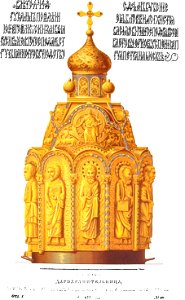The tabernacle, called "jerusalem", made during the reign of grand duke ivan vasilyevich in 1486. Zions, or church jerusalems, were called arks that resembled a church. We know little about their origin and true significance in worship. In the chronicle we read that in 1160 the suzdal prince andrei bogolyubsky built a church golden jerusalem, decorated with precious stones, in the vladimir cathedral. In the cathedral churches of kyiv, novgorod, pskov, vladimir and moscow such jerusalems were carried out during the bishop's service, at the small exit before the gospel and at the great exit instead of the mitre, also in religious processions, and were placed on the throne in the altar. Finally, in the ancient books of the roman catholic church, among other utensils, the sion (sium) is mentioned, which the bishop wore instead of a banner. In the hymns of the eastern orthodox church, sion is sometimes taken in the sense of the jerusalem church, as, for example, in the stichera of the 8th tone: "rejoice, holy sion. " therefore, such an ark is called in old inventories either sion or jerusalem. The church of christ itself is called the highest and new jerusalem in the books of the new testament, and the name of mount zion is understood to mean the triumphant church. According to the legend of a. N. Muravyov, the cathedral churches of the dormition of the mother of god in georgia are given the name of sions because the mistress of the world reposed on mount zion. Two sion, kept in the sacristy of the moscow cathedral of the assumption, in their appearance represent a model of round and square churches, single-domed and five-domed, which were then being built in russia in accordance with the byzantine prototypes. These utensils are silver, gilded, with niello. Named in the inventory of 1616, a large sion, 1 arshin and 3 1/2 vershoks high, 11 vershoks wide, weighing 1 pood 11 pounds and 7 gold pieces; it has the appearance of a round five-domed church, furnished with embossed relief images of the twelve apostles with their names written on them; the half between the columns, on which the holy apostle peter is depicted with a key in his hand, serves as a door into the interior, where only an iron rod in the middle is fixed at the top on iron ties. The top of this temple consists of triple towers, one protruding from the other and, like golgotha, serving as a footstool for the neck with the dome, which is crowned with a four-pointed cross. On the towers, or zakomaras, four prophets are carved, surrounded by winged beasts; the gratings in the windows of the neck, or tribune, consist of coiled snakes. On the scaly dome, larvae of people, birds, and animals are drawn in niello. Two small domes are missing to correspond with the other two. The following inscription, inscribed on the back of the door, testifies to the time and place of the construction of this utensil: in the year, the church was made by order of the pious and christ-loving great prince ivan vasilyevich, lord of all russia in the year of the lordship. To the church of the dormition of the most pure and to the tomb of the miracle worker peter in moscow. Handles are attached to the iron tray of this ark for carrying. Another jerusalem, according to the description of the small zion, depicts a likeness of a single-domed square church, 12 vershoks high, and 5 vershoks wide; it weighs 11 pounds 67 gold. The four sides of this church are decorated with chased faces of jesus christ with the mother of god and the forerunner, the four evangelists and the apostles peter, paul, james, simon and andrew, mostly with books in their hands as signs of their message. The top of the temple consists of triple teremoks, in which half-length images of thirty-six angels are chased. Above the teremoks, four heads with crowns are still visible, probably those of the evangelists. On the neck with latticed windows rises a scaly head, overshadowed by an eight-pointed cross. There is no door into the interior of this zion. Above the cornice is the following inscription: in the year this jerusalem was built by the order of the pious and christ-loving great prince ivan vasilyevich, lord of all russia, in the year of his reign. In the church of the assumption of the holy martyrs and the tomb of the christ-worker peter in moscow. The construction of these jerusalems dates back to 1486, marked by the conquest of the tver principality by the moscow state and the return of the all-russian metropolitan gerontius to his throne. Judging by the style of the monument and the inscriptions, this is a moscow affair. Date: 1846—1853.
Loading...
